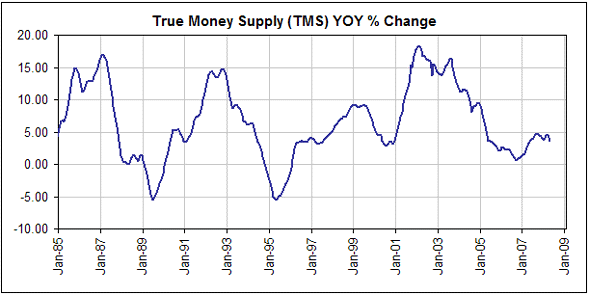|
|||
Bonds and Interest RatesSteve Saville
Inflation Risk and Credit Risk Paul van Eeden recently published a very negative article about bonds (he expects bond prices to tank and interest rates to soar). We don't disagree with Mr. van Eeden's view that interest rates will eventually have to move much higher. We are, after all, long-term bearish on bonds. However, his ultra-bearish view on bonds is partly based on the false premise that the inflation (money-supply growth) rate is currently at the very elevated level of around 17%. Over the past few months we've given a lot of thought to how the money supply should be measured and have discussed some of our thoughts/conclusions in previous commentaries. For example, refer to the "Measuring the money supply" piece in the 21st April Weekly Update. We are still not sure that we have identified the ideal measure of money supply or even if such an ideal exists within today's monetary system, but we are sure that time deposits and institutional money-market funds do not constitute money and should therefore not be counted when determining the total supply of money. This means that M3, the monetary aggregate upon which Mr. van Eeden relies, does not provide a reliable estimation of the money supply. A far more accurate representation of the money supply picture is provided by the "True Money Supply" (TMS) aggregate defined HERE. The following chart shows that the year-over-year (YOY) growth rate of TMS is presently about 3.5%. To put it another way, TMS tells us that the inflation (money-supply growth) rate is presently in the bottom quartile of its 10-year range.  Our statement that the US inflation rate is presently in the bottom quartile of its 10-year range may appear to be absurd given that the prices for various commodities and everyday goods/services are rocketing upward, but today's rising prices are largely due to the massive inflation that occurred years ago; specifically, the massive inflation in the US during 1998-2004 and outside the US during 2003-2006. There is often a multi-year lag between the cause (money-supply growth) and the effect (rising prices), which is one reason why so few people are able to see the link between money-supply changes and purchasing power changes. During any long-term inflation cycle the major beneficiaries of the inflation will be the sectors of the economy where the supply/demand fundamentals are the most bullish; that is, those sectors where there is relative scarcity. Commodities should continue to be the major beneficiaries during the current inflation cycle -- a cycle that's probably nowhere near an end -- because that's where the relative scarcity now lies, but the downward correction in the money-supply growth rate over the past few years creates an intermediate-term hazard for commodity investors. We expect that wider recognition of the inflation problem will eventually bring about a major decline in Treasury bond prices (a major rise in bond yields), but the temporarily SLOW rate of US money-supply growth over the past 2-3 years could support US T-Bond prices over the coming 6 months by putting irresistible downward pressure on the prices of industrial commodities. In addition to inflation risk, Mr. van Eeden points to credit risk as a reason why interest rates must rise. Here we are in almost total agreement. A type of financial alchemy took place over the past several years whereby 'dodgy' debts were packaged up and, with the help of bond insurers and rating agencies, 'magically' transformed into investment-grade bonds with interest rates that reflected minimal default risk. The upshot is that the interest rate on non-Treasury debt is now generally way too low in absolute terms and relative to the interest rate on Treasury debt of comparable duration. We therefore think that a bet against high-risk/high-yield corporate debt and/or a bet on widening credit spreads would make sense. Interest rates will simply have to rise to compensate lenders for the very real risk of default. Keep in mind, though, that there is no direct default risk (credit risk) associated with Treasury debt, only indirect default risk via inflation (the central bank will always be ready, willing and able to purchase all new government debt if other buyers cannot be found). As a result, US Treasuries should not be hurt as the market prices-in greater credit risk. In other words, the increasing awareness of credit risk is a reason to be bearish on NON-government debt. Gold and Bonds The absolute level of the T-Bond yield doesn't play a significant part in our gold market analysis. When inflation fears finally begin to get out of hand the gold price and the T-Bond yield will move sharply higher together, but to perform well gold doesn't need rampant inflation fears and the surge in bond yields that always accompanies such fears. Interest rate differentials, as opposed to any particular interest rate, are what matter as far as gold's prospects are concerned. Regular TSI readers would realise that the interest rate differentials we are referring to are yield spreads (differences between long-term and short-term interest rates) and credit spreads (differences between the interest rates on high risk and relatively low risk debt securities of comparable durations). Our view is that the widening of yield and credit spreads creates a bullish interest-rate backdrop for gold, regardless of whether T-Bond yields happen to be rising or falling. This is because widening yield and credit spreads are symptoms of contracting financial market liquidity and declining confidence. Steve Saville Regular financial market forecasts and analyses are provided at our web site: We aren't offering a free trial subscription at this time, but free samples of our work (excerpts from our regular commentaries) can be viewed at: http://tsi-blog.com Saville Archives |
